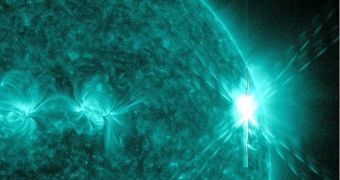A significant number of the 22,000 pieces of large space junk the US Department of Defense keeps track of could be forced to reenter Earth's atmosphere faster than currently possible, in the event of a large solar storm.
The conclusion belongs to a new study conducted by investigators with the NASA Orbital Debris Program, at the Johnson Space Center in Houston, Texas. They say that the solar events tend to cause an expansion of Earth's atmosphere.
This in turn increases the drag the atmosphere usually exerts on space junk, regardless of their altitude. More drag equals more friction, and therefore a more intense breaking effect. This causes the debris to become more likely to succumb to the planet's gravitational pull.
Even though solar storms are generally feared – due to their propensity to fry electronics, satellites and power grids – they are apparently also good for some things. In addition to the large chunks of space debris, there are also many more smaller pieces, so tiny that they cannot be tracked by radar.
Most of these pieces of junk were generated by collisions between space objects, exploded satellites, various rocket stages that were abandoned in mid-flights, and so on. Many of these small artificial satellites have limited lifespans, of just a few decades.
However, they are very dangerous to functional satellites, the International Space Station, and outbound spacecraft or space probe. What experts around the world are now trying to do is find a way of making the junk burn up in the atmosphere as fast as possible.
“Everything is falling down. It's just a question of at what rate,” Nick Johnson explains. He holds an appointment as the chief scientist of the NASA ODP. “When the Sun is more active, it ejects more energy in the direction of Earth,” the expert says.
“That energy is absorbed by the thermosphere, the upper part of the atmosphere,” the investigator explains further. As the layer heats up, it starts to expand further out into space, putting particles at altitudes where only minimal amounts can be usually found.
Thermosphere expansion is an active process, one that occurs on a daily basis. Therefore, it is very difficult to predict exactly how many space debris it will bring back every month, or every year.
What researchers can estimate is whether debris is more likely to fall to Earth in greater numbers during a random year, as opposed to another year. Years when solar activity is heading towards a peak, such as 2012 and 2013, are bound to see the thermosphere swell up to impressive dimensions, Space reports.

 14 DAY TRIAL //
14 DAY TRIAL //